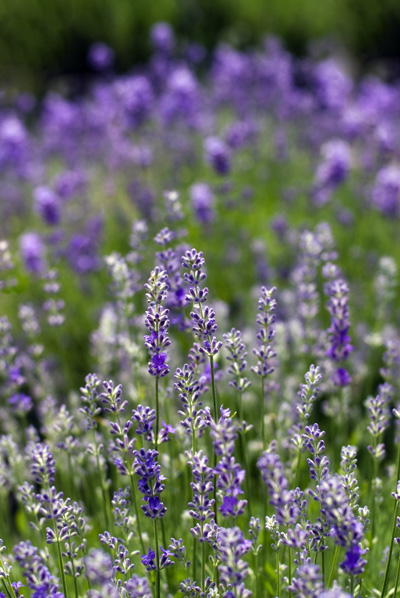Biofarming Lavender by Pegasus Bio Hyper Foods
Growing Lavender
Lavender belongs to the mint family distinguished by its square stems and distinctive fragrance. There are over 15 species of lavender with many different cultivars that span the colour range from pale violet to deep indigo including pink and white cultivars. At our lavender farm we will grow Lavandula angustifolia, because of its more hardy nature wintering in zones 5-8. The soil for lavender should be a pH of about 6-8. The soil type should be lime based, light and well-drained. Although lavender is thought to be a drought-tolerant plant, good irrigation and adequate rainfall are important for establishing new plants and minimizing stress of long hot summers. Pruning plants back in the spring by about 1/3, and not into old wood, is necessary for maintaining a healthy plant. For our lavender, we promote organic growing practices with no chemical intervention.
Though lavender can be found growing all over the world, the best lavender is still produced in its real home, the Mediterranean region. Greek lavender is famous and can be found in sachets in women’s underwear drawers just about everywhere. In a day when people are familiar with very few herbs, lavender is one herb most can identify. Sadly, we know it mostly as a quaint room freshener – its wonderful actions as a drug have been all but forgotten.
As far as plants go, lavender is a small bush. Left to its own devices in the right environment, it will become woody and rather tall. The plant has attractive silver leaves that emit the characteristic lavender scent when bruised. Lavender belongs to the Labiatae family, more commonly known as the mint family. The entire family, including mint, oregano, thyme, sage, and rosemary, is quite fragrant due to the volatile oils they contain.
The volatile oil in lavender is made up of linalyl acetate, linalool, lanvandulyl acetate, borneol, camphor, limonene, cadinene, caryophyllene, and some other rather long-named ingredients. Volatile oils, like volatile people, are not stable. If you put a drop of volatile oil on a piece of brown paper and left the paper on the kitchen counter overnight, you would discover in the morning that the oil had evaporated. Nonvolatile oils, like sunflower or olive oil, don’t evaporate as you well know; once they or on a shirt or bit of fabric, they are always there. The plant also contains coumarins including umbelliferone, herniarin, and dihydrocoumarin. Other chemicals in lavender include triterpenes and flavonoids.
The ancient Greeks knew of lavender and its powerful fragrance. They called it nardus because at that time the best lavender came from a Syrian city called Narda. The Greeks imported the flower heads in quantity to scent rooms and to be used in medicine. The Romans were a little apprehensive when it came to lavender as they were convinced that a poisonous snake, the asp, liked to live among the lavender bushes. This didn’t stop them from buying the dried flowers once someone else had risked his life picking lavender in the countryside. However, it made dried lavender one of the more expensive medicinal items at the market. From its first appearance in the written record, lavender was used for scent. The ancient Libyans made a perfume of it, and the Romans used it for bathing. Its scientific name, Lavandula, comes from the Latin lavare, "to wash." Lavender made its way to northern Europe well before the Middle Ages and was used for both medicine and scent.
As soon as lavender appears in the medical literature, we see it in use for the brain and all its connecting parts and for the illnesses that affect them. In 1995, smelling salts, which are used to rouse a person who has fainted, are still made of the essential oil of lavender blossoms. Lavender’s medicinal actions stop short of raising the dead, but its traditional use in smelling salts hints at its considerable powers.
The essential oil or a spirit of lavender made from it, proves admirably restorative and tonic against faintness, palpitations of a nervous sort, weak giddiness, spasms, and colic. It is agreeable in taste and smell, provokes appetite, raises the spirits and dispels flatulence… outwardly applied it relieves tooth ache, neuralgia, sprains, and rheumatism. In hysteria, palsy, and similar disorders of debility and lack of nerve power, lavender will act as a powerful stimulant… In some cases of mental depression and delusions, oil of lavender proves a real service, and a few drops rubbed on the temple will cure nervous headache… A tea brewed from lavender tops, made in moderate strength, is excellent to relieve headache from fatigue and exhaustion.
Every country has its own official book of remedies. In the United States it is called the U.S. Pharmacopoeia, and in Britain, it is called the British National Pharmacopoeia. Today such books are filled with lists of drugs produced by drug manufacturers; in the past, they were filled with lists of medicinal plants. The British National Pharmacopoeia includes the following information on lavender, citing its use: "Against the falling sickness and all cold distempers of the head, womb, stomach, and nerves; against apoplexy, palsy, convulsions, megrim, vertigo, loss of memory, dimness of sight, melancholy, swooning fits." It’s amazing that a plant so well known and respected for its ability to treat headaches and nervous disorders should have been forgotten. Mr. Bayer and his descendants are quite rich by now, and poor lavender has been relegated to the panties drawer. Not for long, though.
Headaches, are caused by muscular tension in the neck and head, vascular tension, food allergies, chemical poisoning, brain tumors, and trapped nerves, among other things. As usual, the stress factor rears its ugly head. A day on the highway and at the job results in your tensing up. As you clench the muscles of the face and neck, nerves get pinched, and you end up with a headache. However, head pain is only one possible symptom of stress. Whether the symptom of stress is headache, insomnia, or anxiety, lavender can be of great help.
 So, it seems lavender can be used to remedy a stress-tension victim, regardless of how they are manifesting their stress! The most common symptom, headache will be helped, but, other problems like anxiety attacks, insomnia, and general nervousness are equally improved with its use.
So, it seems lavender can be used to remedy a stress-tension victim, regardless of how they are manifesting their stress! The most common symptom, headache will be helped, but, other problems like anxiety attacks, insomnia, and general nervousness are equally improved with its use.
Practitioners’ Advice
Stress does all kinds of weird things to the nervous system. When the nervous system is under great stress eyes twitch, sleep becomes poor, headaches thunder, necks go into cramps, and anxiety attacks occur. The real solution is to do what you can to reduce your stress. Life simplification will go a long way to take the burden off the nervous system! Do what you can to reduce your stress and chances are your headaches or insomnia will go away. Lavender can be used as a part of a stress reduction program and indeed will add incredibly to such a program.
When it comes to using lavender, you have two options. The first is to use the tincture of lavender, a fluid extract made from the flowers. This is taken internally three times a day and will keep a person relaxed and keep the symptoms of stress under control. Additionally, one can use lavender essential oil, either applied directly to the skin or added to a hot bath, to resolve the symptoms of stress.

 Cultivations
Cultivations 



